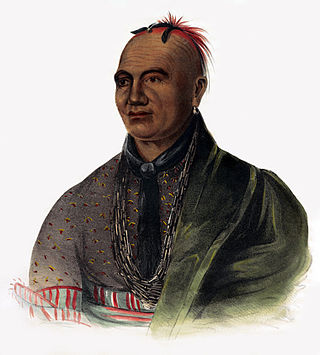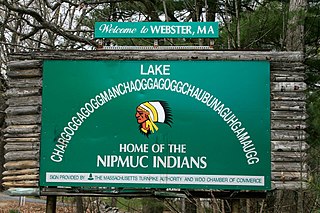Related Research Articles

New Haven County is a county in the south central part of the U.S. state of Connecticut. As of the 2020 census, the population was 864,835, making it the third-most populous county in Connecticut. Two of the state's top 5 largest cities, New Haven (3rd) and Waterbury (5th), are part of New Haven County.

The Miami are a Native American nation originally speaking one of the Algonquian languages. Among the peoples known as the Great Lakes tribes, they occupied territory that is now identified as north-central Indiana, southwest Michigan, and western Ohio. The Miami were historically made up of several prominent subgroups, including the Piankeshaw, Wea, Pepikokia, Kilatika, Mengakonkia, and Atchakangouen. In modern times, Miami is used more specifically to refer to the Atchakangouen. By 1846, most of the Miami had been forcefully displaced to Indian Territory. The Miami Tribe of Oklahoma are the federally recognized tribe of Miami Indians in the United States. The Miami Nation of Indiana, a nonprofit organization of self-identified descendants of Miamis who were exempted from removal, have unsuccessfully sought separate recognition.

Branford is a shoreline town located on Long Island Sound in New Haven County, Connecticut, United States, about 6 miles (10 km) east of downtown New Haven. The town is part of the South Central Connecticut Planning Region. Branford borders East Haven to the west, Guilford to the east, and North Branford to the north. The population was 28,273 in the 2020 census.

The Narragansett people are an Algonquian American Indian tribe from Rhode Island. Today, Narragansett people are enrolled in the federally recognized Narragansett Indian Tribe. They gained federal recognition in 1983.

The Quinnipiac were a historical Indigenous people of the Northeastern Woodlands. They lived in present-day New Haven County, Connecticut, along the Quinnipiac River. Their primary village, also called Quinnipiac, was where New Haven, Connecticut is today.

The Shawnee are a Native American people of the Northeastern Woodlands. Their language, Shawnee, is an Algonquian language.

The Algonquians are one of the most populous and widespread North American native language groups. They historically were prominent along the Atlantic Coast and in the interior regions along Saint Lawrence River and around the Great Lakes. This grouping consists of the peoples who speak Algonquian languages.

The Wyandotte Nation is a federally recognized Native American tribe headquartered in northeastern Oklahoma. They are descendants of the Wendat Confederacy and Native Americans with territory near Georgian Bay and Lake Huron. Under pressure from Haudenosaunee and other tribes, then from European settlers and the United States government, the tribe gradually moved south and west to Michigan, Ohio, Kansas, and finally Oklahoma in the United States.

The Connecticut Yankee Council of the Boy Scouts of America is located in Milford, Connecticut. It is council #072 and serves 37 towns and cities in Connecticut, including Fairfield, New Haven, and parts of Hartford counties. The present council was formed in 1998 by the merger of Quinnipiac Council (#074) and Fairfield County Council (#068).Owaneco Lodge is the Order of the Arrow lodge that serves this council.

The Gros Ventre, also known as the Aaniiih, A'aninin, Haaninin, Atsina, and White Clay, are a historically Algonquian-speaking Native American tribe located in northcentral Montana. Today, the Gros Ventre people are enrolled in the Fort Belknap Indian Community of the Fort Belknap Reservation of Montana, a federally recognized tribe with 7,000 members, also including the Assiniboine people.
State-recognized tribes in the United States are organizations that identify as Native American tribes or heritage groups that do not meet the criteria for federally recognized Indian tribes but have been recognized by a process established under assorted state government laws for varying purposes or by governor's executive orders. State recognition does not dictate whether or not they are recognized as Native American tribes by continually existing tribal nations.
The Chickahominy are a federally recognized tribe of Virginian Native Americans who primarily live in Charles City County, located along the James River midway between Richmond and Williamsburg in the Commonwealth of Virginia. This area of the Tidewater is not far from where they were living in 1600, before the arrival of colonists from England. They were officially recognized by the state in 1983 and by the federal government in January 2018.

Indigenous peoples of the Northeastern Woodlands include Native American tribes and First Nation bands residing in or originating from a cultural area encompassing the northeastern and Midwest United States and southeastern Canada. It is part of a broader grouping known as the Eastern Woodlands. The Northeastern Woodlands is divided into three major areas: the Coastal, Saint Lawrence Lowlands, and Great Lakes-Riverine zones.

Short Beach is a beach neighborhood situated in Branford, Connecticut. It is the westernmost of Branford's seven neighborhoods, the others being: The Hill, The Center, Pine Orchard, Stony Creek, Indian Neck, and Brushy Hill. Short Beach's population is approximately 2,500. About a half mile long, it is situated in New Haven County and is bordered by East Haven to the west, Branford to the north and east and Long Island Sound to the south. It is home to many small islands, the largest being Kelsey's Island which has a few small cabins used as summer homes.

The Shinnecock Indian Nation is a federally recognized tribe of historically Algonquian-speaking Native Americans based at the eastern end of Long Island, New York. This tribe is headquartered in Suffolk County, on the southeastern shore. Since the mid-19th century, the tribe's landbase is the Shinnecock Reservation within the geographic boundaries of the Town of Southampton. Their name roughly translates into English as "people of the stony shore".

The Webster/Dudley Band of Chaubunagungamaug Nipmuck Indians, also known as the Chaubunagungamaug, Chaubunagungamaug Nipmuck, Pegan or Dudley/Webster Indians, is a cultural heritage group that claims descent from the Nipmuc people. They are an unrecognized tribe, meaning they are neither federally recognized nor state-recognized, unlike the Hassanamisco Nipmuc Band.
The Mohegan are an Algonquian Native American tribe historically based in present-day Connecticut. Today the majority of the people are associated with the Mohegan Indian Tribe, a federally recognized tribe living on a reservation in the eastern upper Thames River valley of south-central Connecticut. It is one of two federally recognized tribes in the state, the other being the Mashantucket Pequot, whose reservation is in Ledyard, Connecticut. There are also three state-recognized tribes: the Schaghticoke, Paugusett, and Eastern Pequot.
Iron Thunderhorse is an author and prisoner in Texas.

The Quinnipiac Trail is a 24-mile (39 km) Blue-Blazed hiking trail in New Haven County, Connecticut. It is the product of the evolution and growth of the first 10.6-mile (17.1 km) trail designated in Connecticut's Blue-Blazed Hiking Trail system, with its light-blue rectangular vertical painted blazes.
References
- 1 2 3 4 5 "Algonquian Confederacy of the Quinnipiac Tribal Council, Inc., The". OpenCorporates. Retrieved April 4, 2023.
- 1 2 3 4 5 6 7 8 "Algonquian Confederacy of the Quinnipiac Tribal Council Inc". GuideStar. Retrieved 5 April 2023.
- ↑ Lavin, Lucianne (2013). Connecticut's Indigenous Peoples. New Haven, CT: Yale University Press. p. xiii. ISBN 9780300186642.
- ↑ Indian Affairs Bureau (12 January 2023). "Indian Entities Recognized by and Eligible To Receive Services From the United States Bureau of Indian Affairs". Federal Register. 88: 2112–16. Retrieved April 4, 2023.
- 1 2 3 Page, Suzi (October 12, 2016). "Branford's Running Fox works to keep Quinnipiac culture alive; Artifacts on view at Dudley Farm". CT Insider. Retrieved 5 April 2023.
- ↑ "State Recognized Tribes". National Conference of State Legislatures. Archived from the original on 1 September 2022. Retrieved 6 April 2017.
- ↑ MacMillan, Thomas (March 26, 2012). "Little Owl Speaks". New Haven Independent. Retrieved 5 April 2023.
- ↑ Misur, Susan (June 25, 2011). "Powwow at East Haven church strengthens community bonds". New Haven Register. Retrieved 5 April 2023.
- ↑ "Langscape" (PDF). Terralingua. September 2000. p. 20.
- 1 2 Beach, Randall (January 4, 2022). "The legacy of the Quinnipiac people endures in a soon-to-be-upgraded viewing space". CT Insider. Retrieved 5 April 2023.